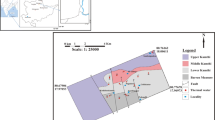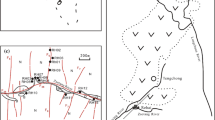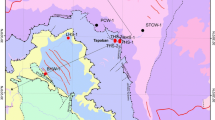Abstract
Gujarat area situated in the Cambay rift basin of western India is one of the potential geothermal fields due to its enormous prospects as an oil and gas producing reservoir. The present study attempts to better constrain reservoir temperature by employing the multicomponent fluid geothermometry technique. As the thermal waters in this region undergo extensive mixing with non-thermal saline waters; most of the chemical geothermometers fail to provide the correct estimation of reservoir temperature. For example, the silica and K–Mg geothermometers predict reservoir temperatures below the surface discharge temperatures of the thermal fluids, whereas Na–K and Na–Li geothermometers estimate a wide range of subsurface temperatures (169–226 °C). Na–K–Ca geothermometer computes 158–175 °C as reservoir temperature for thermal waters from Lasundra, Tuwa, and Tulsishyam regions. To solve this ambiguity and to better constrain the reservoir temperature, a multicomponent geothermometry modelling is carried out using GeoT program. Fluid reconstruction is carried out by incorporating the dilution phenomenon. The GeoT modelling of the reconstructed fluids at Dholera region (DH-1) determines the subsurface temperature in the range of 138 ± 7 °C, which matches closely with the values obtained from Na–K–Ca geothermometer (120–126 °C). In the case of thermal waters from Lasundra, Tuwa, and Tulshishaym regions, the GeoT modelling results give a concordant estimation of reservoir temperature in the range of ~ 165 ± 10 °C. This integrated multicomponent method thus emerges as the only viable alternative in providing the correct estimation of reservoir temperature in medium enthalpy geothermal systems.










Similar content being viewed by others
Data availability
All the data is given in this article.
References
APHA (American Public Health Association) (1995) Standard methods for the examination of water and wastewater, 19th edn. American Public Health Association, Washington, DC, pp 4–122
Arnorsson S (1983) Chemical equilibria in Icelandic geothermal systems-implications for chemical geothermometry investigations. Geothermics 12:119–128
Arnorsson S (2000) Isotopic and chemical techniques in geothermal exploration, development and use. International Atomic Energy Agency, Vienna, pp 154–170
Arnórsson S, Andrésdóttir A (1995) Processes controlling the distribution of boron and chlorine in natural waters in Iceland. Geochim Cosmochim Acta 59:4125–4146. https://doi.org/10.1016/0016-7037(95)00278-8
Arnórsson S, Gunnlaugsson E (1985) New gas geothermometers for geothermal exploration-Calibration and application. Geochim Cosmochim Acta 49:1307–1325
Battistel M, Hurwitz S, Evans W, Barbieri M (2014) Multicomponent geothermometry applied to a medium-low enthalpy carbonate-evaporite geothermal reservoir. Energy Procedia 59:359–365
Byrne DJ, Broadley MW, Halldórsson SA et al (2021) The use of noble gas isotopes to trace subsurface boiling temperatures in Icelandic geothermal systems. Earth Planet Sci Lett 560:116805
Chatterjee S, Sinha UK, Deodhar AS, Ansari MA, Singh N, Srivastava AK, Aggarwal RK, Dash A (2017) Isotope-geochemical characterization and geothermometrical modeling of Uttarakhand geothermal field, India. Environ Earth Sci 76:638. https://doi.org/10.1007/s12665-017-6973-2
Chatterjee S, Sinha UK, Biswal BP, Jaryal A, Patbhaje S, Dash A (2019) Multicomponent versus classical geothermometry: applicability of both geothermometers in a medium-enthalpy geothermal system in India. Aquat Geochem 25:91–108. https://doi.org/10.1007/s10498-019-09355-w
Chatterjee S, Mishra P, Sasi Bhushan K, Goswami P, Sinha UK (2023) Unraveling the paleo-marine signature in saline thermal waters of Cambay rift basin, Western India: Insights from geochemistry and multi isotopic (B, O and H) analysis. Mar Pollut Bull 192:115003. https://doi.org/10.1016/j.marpolbul.2023.115003
Chiodini G, Marini L (1998) Hydrothermal gas equilibria: the H2O–H2-CO2-CO-CH4 system. Geochim Cosmochim Acta 62:2673–2687. https://doi.org/10.1016/S0016-7037(98)00181-1
Fernandez-Turiel J, Llorens J, Lopez-Vera F, Gomez-Artola C, Morell I, Gimeno D (2000) Strategy for water analysis using ICP-MS. Fresenius J Anal Chem 368:601–606. https://doi.org/10.1007/s002160000552
Fournier RO (1977) Chemical geothermometers and mixing models for geothermal systems. Geothermics 5:40–41
Fournier RO (1989) The solubility of silica in hydrothermal solutions: practical applications. In: Lectures on geochemical interpretation of hydrothermal water. UNU geothermal training programme, report 10, Raykjavik, Iceland
Fournier RO (1979a) A revised equation for Na/K geothermometer. Geotherm Resour Council Trans 3:221–224
Fournier RO (1979b) Geochemical and hydrologic considerations and the use of enthalpy-chloride diagrams in the prediction of underground conditions in hot-spring systems. J Volcanol Geotherm Res 5:1–16
Fournier RO, Truesdell AH (1973) An empirical Na–K–Ca geothermometer from natural waters. Geochim Cosmochim Acta 37:1255–1275
Giggenbach WF (1980) Geothermal gas equilibria. Geochim Cosmochim Acta 44:2021–2032. https://doi.org/10.1016/0016-7037(80)90200-8
Giggenbach WF (1988) Geothermal solute equilibria. Derivation of Na–K–Mg–K geoindicators. Geochim Cosmochim Acta 52:2749–2765
Giggenbach WF (1995) Variations in the chemical and isotopic composition of fluids discharged from the Taupo Volcanic Zone, New Zealand. J Volcanol Geoth Res 68:89–116. https://doi.org/10.1016/0377-0273(95)00009-J
Goff F, Shevenell L, Gardner JN, Vuataz FD, Grigsby CO (1988) The hydrothermal outflow plume of Valles caldera, New Mexico, and a comparison with other outflow plumes. J Geophys Res 93:6041–6058. https://doi.org/10.1029/JB093iB06p06041
GSI (Geological Survey of India) (2001) Geology and mineral resources of Gujarat, Daman and Diu. Geol. Surv. Ind. Spl. Pub., No. 30 (XIV), pp 1–111
GSI (Geological Survey of India) (2017) Geology and mineral resources of Gujarat, Daman and Diu. Geol. Surv. Ind. Spl. Pub., No. 30 (Part 14), pp 1–137
Gupta SK, Deshpande RD (2003) Origin of groundwater helium and temperature anomalies in the Cambay region of Gujarat, India. Chem Geol 198:33–46. https://doi.org/10.1016/S0009-2541(02)00422-9
Hou Z, Xu T, Lia S, Jiang Z, Feng B, Cao Y, Fenga G, Yuan Y, Hu Z (2019) Reconstruction of different original water chemical compositions and estimation of reservoir temperature from mixed geothermal water using the method of integrated multicomponent geothermometry: a case study of the Gonghe Basin, northeastern Tibetan Plateau. China Appl Geochem 108:104389. https://doi.org/10.1016/j.apgeochem.2019.104389
Keenan JH, Keyes FG, Hill PG, Moore JG (1969) Steam tables—thermodynamic properties of water including vapour, liquid and solid phases (international edition—metric units). Wiley, New York, p 162
Keesari T, Sinha UK, Deodhar A, Krishna SH, Ansari A, Mohokar H, Dash A (2016) High fluoride in groundwater of an industrialized area of Eastern India (Odisha): inferences from geochemical and isotopic investigation. Environ Earth Sci. https://doi.org/10.1007/s12665-016-5874-0
Keesari T, Chatterjee S, Kumar M, Mohokar H, Sinha UK, Roy A, Pant D, Patbhaje SD (2022) Tracing thermal and non-thermal water circulations in shear zones of Eastern Ghats Mobile Belt zone Eastern India- inferences on sustainability of geothermal resources. J Hydrol 612:128172. https://doi.org/10.1016/j.jhydrol.2022.128172
Kharaka YK, Lico MS, Law LM (1982) Chemical geothermometers applied to formation waters, Gulf of Mexico and California Basins (abstract). Am Ass Petrol Geol Bull 66:588
Legros H, Marignac C, Mercadier J, Cuney M, Richard A, Wang RC et al (2016) Detailed paragenesis and Li-mica compositions as recorders of the magmatic-hydrothermal evolution of the Maoping W-Sn deposit (Jiangxi, China). Lithos 264:108–124. https://doi.org/10.1016/j.lithos.2016.08.022
Lopez JG, Pirez IS, Fernández-Nieto C, Gonzalez IF (1993) Lithium-bearing hydrothermal alteration phyllosilicates related to Portalet fluorite ore (Pyrenees, Huesca, Spain). Clay Miner 28:275–283. https://doi.org/10.1180/claymin.1993.028.2.08
Merh S (1995) Geology of Gujarat. Geological Society of India, Bangalore, p 224
Minissale A, Chandrasekharam D, Vaselli O, Magro G, Tassi F, Pansini GL, Bhramhabut A (2003) Geochemistry, geothermics and relationship to active tectonics of Gujarat and Rajasthan thermal discharges. India J Volcanol Geotherm Res 127(1–2):19–32
Nicholson K (1993) Geothermal fluids chemistry and exploration techniques. Springer, Berlin, pp 22–23
Nieva D, Nieva R (1987) Developments in geothermal energy in Mexico, Part 12. A cationic geothermometer for prospecting of geothermal resources. Heat Recov Syst CHP 7:243–258
Nitschke F, Held S, Villalon I, Neumann T, Kohl T (2017) Assessment of performance and parameter sensitivity of multicomponent geothermometry applied to a medium enthalpy geothermal system. Geotherm Energy 5:12. https://doi.org/10.1186/s40517-017-0070-3
Nitschke F, Held S, Neumann T, Kohl T (2018) Geochemical characterization of the Villarrica geothermal system, Southern Chile, part II: site-specific re-evaluation of SiO2 and Na-K solute geothermometers. Geothermics 74:217–225. https://doi.org/10.1016/j.geothermics.2018.03.006
Olguín-Martínez MG, Peiffer L, Dobson PF, Spycher N, Inguaggiato C, Wanner C, Hoyos A, Wurl J, Makovsky K, Ruiz-Aguilar D (2022) PyGeoT: a tool to automate mineral selection for multicomponent geothermometry. Geothermics 104(7):102467. https://doi.org/10.1016/j.geothermics.2022.102467
Pan S, Kong YL, Wang K, Ren YQ, Pang ZH, Zhang C, Wen DG, Zhang LY, Feng QD, Zhu GL, Wang JY (2021) Magmatic origin of geothermal fluids constrained by geochemical evidence: implications for the heat source in the northeastern Tibetan Plateau. J Hydrol 603:126985. https://doi.org/10.1016/j.jhydrol.2021.126985
Pang ZH, Reed MH (1998) Theoretical chemical thermometry on geothermal waters: problems and methods. Geochim Cosmochim Acta 62:1083–1091
Pentecost A, Jones B, Renaut RW (2003) What is a hot spring? Can J Earth Sci 40(11):1443–1446. https://doi.org/10.1139/e03-083
Rao GSP, Tewari HC (2005) The seismic structure of the Saurashtra crust in northwest India and its relationship with the Reunion Plume. Geophys J Int 160(1):318–330
Reed MH, Spycher NF (1984) Calculation of pH and mineral equilibria in hydrothermal waters with application to geothermometry and studies of boiling and dilution. Geochim Cosmochim Acta 48:1479–1492
Shah M, Sircar A, Shaikh N, Patel K, Sharma S, Vaidya D (2019) Comprehensive geochemical/hydrochemical and geo-thermometry analysis of Unai geothermal field, Gujarat, India. Acta Geochim 38:145. https://doi.org/10.1007/s11631-018-0291-6
Shah M, Sircar A, Shah V, Dholakia Y (2021) Geochemical and geothermometry study on hot-water springs for understanding prospectivity of low enthalpy reservoirs of Dholera Geothermal field, Gujarat, India. Solid Earth Sci 6:297–312. https://doi.org/10.1016/j.sesci.2021.04.004
Shoedarto RM, Tadaa Y, Kashiwaya K, Koikea K, Iskandar I (2020) Specifying recharge zones and mechanisms of the transitional geothermal field through hydrogen and oxygen isotope analyses with consideration of water-rock interaction. Geothermics 86:101797. https://doi.org/10.1016/j.geothermics.2019.101797
Singh HK, Thankappan A, Mohite P, Sinha SK, Chandrasekharam D, Chandrasekhar T (2018) Geothermal energy potential of Tulsishyam thermal springs of Gujarat, India. Arab J Geosci 11:137. https://doi.org/10.1007/s12517-018-3501-y
Spycher N, Peifer L, Sonnenthal E, Saldi G, Reed MH, Kennedy BM (2014) Integrated multicomponent solute geothermometry. Geothermics 51:113–123
Srikarni C, Das S (1996) Stratigraphy and sedimentation history of Champaner Group, Gujarat. J Indian Assoc Sedim 15:93–108
Tonani F (1980) Some remarks on the application of geochemical techniques in geothermal exploration. In: Proceedings adv. Eur. Geoth. res., second symp., Strasbourg, pp 428–443
Truesdell AH, Fournier RO (1977) Procedure for estimating the temperature of a hot water component in mixed water using a plot of dissolved silica vs. enthalpy. J Res Geol Surv 5(1):49–52
Trumbull RB, Slack JF (2018) Boron isotopes in the continental crust: granites, pegmatites, felsic volcanic rocks, and related ore deposits. In: Marschall H, Foster G (eds), Boron isotopes. Advances in isotope geochemistry, pp 249–272. https://doi.org/10.1007/978-3-319-64666-4_10
Verma SP, Pandarinath K, Santoyo E (2008) SolGeo: a new computer program for solute geothermometers and its application to Mexican geothermal fields. Geothermics 37(6):597–621
Xu T, Hou Z, Jia X, Spycher N, Jiang Z, Feng B, Na J, Yuan Y (2016) Classical and integrated multicomponent geothermometry at the Tengchong geothermal field, Southwestern China. Environ Earth Sci 75:1502. https://doi.org/10.1007/s12665-016-6298-6
Yadav K, Sircar A (2019) Integrated 2D joint inversion models of gravity, magnetic and MT for geothermal potentials: a case study from Gujarat, India. Model Earth Syst Environ Springer 5(3):963–983
Acknowledgements
The authors wish to thank Dr. P. K. Mohapatra, AD, RC&I group, and the officers of GSI associated with this study for their active support and encouragement during the course of the investigation.
Funding
The authors have not disclosed any funding.
Author information
Authors and Affiliations
Contributions
SC: conceptualization, investigation, methodology, data curation, and draft writing. PM: investigation, sampling, and methodology. TK: supervision, reviewing, and editing manuscript. HJP: project administration and supervision.
Corresponding author
Ethics declarations
Competing interests
The authors declare no competing interests.
Additional information
Publisher's Note
Springer Nature remains neutral with regard to jurisdictional claims in published maps and institutional affiliations.
Supplementary Information
Below is the link to the electronic supplementary material.
Rights and permissions
Springer Nature or its licensor (e.g. a society or other partner) holds exclusive rights to this article under a publishing agreement with the author(s) or other rightsholder(s); author self-archiving of the accepted manuscript version of this article is solely governed by the terms of such publishing agreement and applicable law.
About this article
Cite this article
Chatterjee, S., Mishra, P., Keesari, T. et al. Why is it imperative to use multicomponent geothermometry in medium/low enthalpy thermal waters? Insights from the Gujarat geothermal region, India. Environ Earth Sci 82, 557 (2023). https://doi.org/10.1007/s12665-023-11241-2
Received:
Accepted:
Published:
DOI: https://doi.org/10.1007/s12665-023-11241-2




